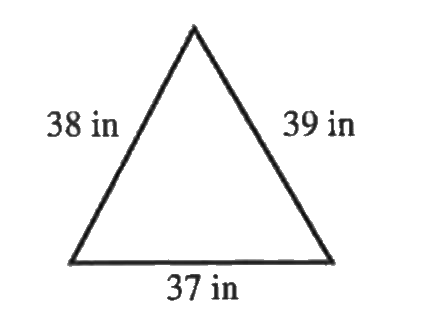In any parallelogram if aandb are the length of the two non-parallel sides, θ is the angle measure between these two sides and d is the length of the diagonal that has a common vertex with sides aandb, then show that the measure of d can be given be : d2=a2+b2+2abcosx
To prove that in a parallelogram, the length of the diagonal d can be expressed as d2=a2+b2+2abcosθ, where a and b are the lengths of the two non-parallel sides and θ is the angle between them, we can follow these steps:
Step 1: Draw the Parallelogram
Draw a parallelogram ABCD where AB=a, AD=b, and the angle between sides AB and AD is θ. The diagonal AC is what we are interested in, and we denote its length as d.
Step 2: Extend the Side
Extend the side AD beyond point D and draw a perpendicular from point B to this extended line. Let the foot of the perpendicular be point M.
Step 3: Identify Lengths
In the parallelogram:
- The length AB=a
- The length AD=b
- The angle ABM=θ
Step 4: Use Trigonometric Ratios
In triangle CDM:
- Using the cosine function, we have:
cosθ=DMCD⟹DM=CD⋅cosθ=acosθ
- Using the sine function, we have:
sinθ=CMCD⟹CM=CD⋅sinθ=asinθ
Step 5: Apply the Pythagorean Theorem
In triangle ACM, since AM is perpendicular to CM, we can apply the Pythagorean theorem:
AC2=AM2+CM2
Here, AC=d, AM=b+acosθ, and CM=asinθ:
d2=(b+acosθ)2+(asinθ)2
Step 6: Expand the Equation
Now, expand the equation:
d2=(b2+2b(acosθ)+(acosθ)2)+(a2sin2θ)
This simplifies to:
d2=b2+2abcosθ+a2cos2θ+a2sin2θ
Step 7: Use the Pythagorean Identity
Using the identity sin2θ+cos2θ=1:
a2cos2θ+a2sin2θ=a2(cos2θ+sin2θ)=a2
Thus, we have:
d2=b2+2abcosθ+a2
Step 8: Rearranging the Terms
Rearranging gives:
d2=a2+b2+2abcosθ
This completes the proof.
Draw a parallelogram ABCD where AB=a, AD=b, and the angle between sides AB and AD is θ. The diagonal AC is what we are interested in, and we denote its length as d.
Extend the side AD beyond point D and draw a perpendicular from point B to this extended line. Let the foot of the perpendicular be point M.
In the parallelogram:
- The length AB=a
- The length AD=b
- The angle ABM=θ
In triangle CDM:
- Using the cosine function, we have:
cosθ=DMCD⟹DM=CD⋅cosθ=acosθ
- Using the sine function, we have:
sinθ=CMCD⟹CM=CD⋅sinθ=asinθ
In triangle ACM, since AM is perpendicular to CM, we can apply the Pythagorean theorem:
AC2=AM2+CM2
Here, AC=d, AM=b+acosθ, and CM=asinθ:
d2=(b+acosθ)2+(asinθ)2
Now, expand the equation:
d2=(b2+2b(acosθ)+(acosθ)2)+(a2sin2θ)
This simplifies to:
d2=b2+2abcosθ+a2cos2θ+a2sin2θ
Using the identity sin2θ+cos2θ=1:
a2cos2θ+a2sin2θ=a2(cos2θ+sin2θ)=a2
Thus, we have:
d2=b2+2abcosθ+a2
Rearranging gives:
d2=a2+b2+2abcosθ
This completes the proof.
Similar Questions
The lengths of two sides of a triangle are 12 cm and 15 cm. Between what two measures should the length of the third side fall?
View SolutionTwo sides of a triangle are to have lengths 'a'cm & 'b'cm. If the triangle is to have the maximum area, then the length of the median from the vertex containing the sides 'a' and 'b'is
View Solution
Knowledge Check
The triangle shown below has side lengths 37, 38 and 39 inches. Which of the following expression gives the measure of the largest angle of the triangle?
(Note : For every triangle with sides of length a, b and c that are opposite ∠A,∠B,and∠C, respectively. c2=a2+b2−2abcosC.)
 Acos−1(−372−382−3922(38)(39))Bcos−1(−392−372−3822(37)(38))Ccos−1(372−382−392+2(38)(39))Dcos−1(382−372−392+2(37)(39))
Acos−1(−372−382−3922(38)(39))Bcos−1(−392−372−3822(37)(38))Ccos−1(372−382−392+2(38)(39))Dcos−1(382−372−392+2(37)(39))
In a triangle, the lengths of the two larger sides are 10 and 9, respectively. If the angles are in A.P, then the length of the third side can be (a) 5−√6 (b) 3√3 (c) 5 (d) 5+√6
View SolutionIn a triangle, the lengths of the two larger sides are 10 and 9, respectively. If the angles are in A.P., then the length of the third side can be 5−√6 (b) 3√3 (c) 5 (d) 5+√6
View SolutionIf the area(!) and an angle(θ) of a triangle are given , when the side opposite to the given angle is minimum , then the length of the remaining two sides are
View SolutionDraw five triangles and measure their sides. Check in each case, if the sum of the lengths of any two sides is always less than the third side.
View SolutionIf the lengths of the sides of a triangle are a - b , a + b and √3a2+b2,(a,b>,0), then the largest angle of the triangle , is
View SolutionIf two sides of a triangle are 8 cm and 13 cm, then the length of the third side is between a cm and b cm. Find the values of a and b such that a is less than b.
View SolutionIf two sides of a triangle are 8 cm and 13 cm, then the length of the third side is between a cm and b cm. Find the values of a and b such that a is less than b.
View Solution
